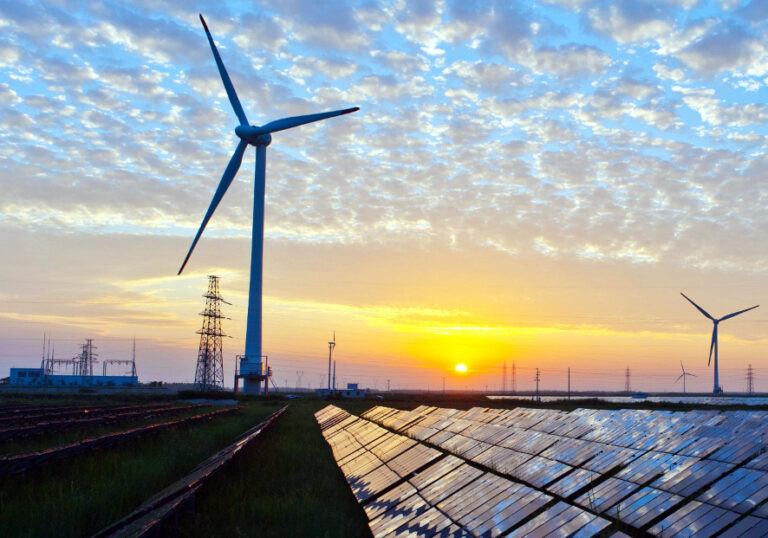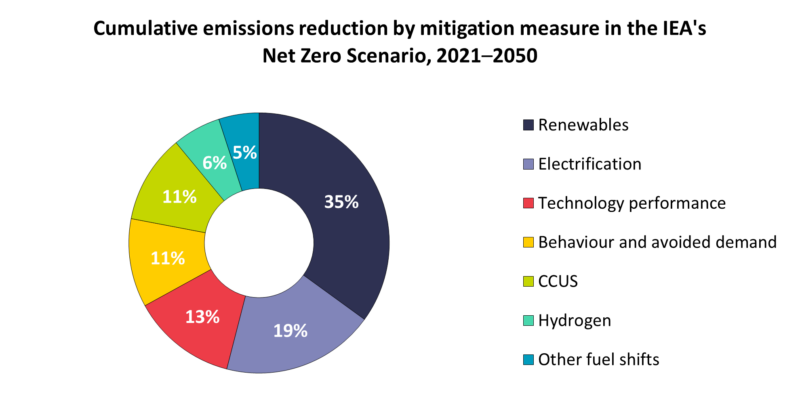What technology do we need to cut carbon emissions?

If the world is to have a credible chance at limiting global warming to 1.5°C to avoid the worst impacts of climate change, global carbon dioxide (CO2) emissions need to reach net zero by the early 2050s, according to the Intergovernmental Panel on Climate Change. It is especially crucial to find ways to reduce emissions from the energy sector, as it is responsible for around three-quarters of global greenhouse gas emissions. Technology and technological innovation has already been a key enabler of reducing emissions from energy systems around the world, but if we are to reach global net zero targets, this needs to accelerate.
Geographical, political, economic and social circumstances will determine the exact pathways to transitioning energy systems in different parts of the world to net zero. However, broadly speaking, cutting carbon emissions from the global energy system requires accelerating the deployment of technologies to achieve two objectives: (i) electrifying as much of the energy demand as possible; and (ii) fully decarbonising electricity supply, using renewable sources in particular.
Electrification and renewables represent the two most significant mitigation measures in the International Energy Agency’s (IEA) 2021–2050 Net Zero Scenario, accounting for 54% of the required emissions reductions (see figure below).

Source: International Energy Agency, ‘Cumulative emissions reduction by mitigation measure in the Net Zero Scenario, 2021-2050’.
Notes: ‘Other fuel shifts’ refers to switching from coal and oil to natural gas, nuclear, hydropower, geothermal, concentrating solar power or marine energy. ‘CCUS’ is carbon capture, usage and storage.
Electrification
Electrifying energy demand refers to using low-carbon electricity to meet energy needs that have traditionally come from fossil fuels. This is made possible by technological switches such as replacing internal combustion engine vehicles with electric vehicles and replacing natural gas or oil boilers with heat pumps to heat buildings. In industry, clean electricity can be used instead of fossil fuels to provide low- and medium-temperature heat or to power certain steel production processes. Electrification holds great potential to reduce final energy demand and consequently emissions because electric technologies tend to be inherently more efficient than fossil fuel-based alternatives that provide similar energy services. Indeed, the IEA estimates that electrification could provide almost one-fifth (19%) of the cumulative emissions reductions required to achieve a net zero energy system by 2050.
Of course, electrification only reduces emissions to a meaningful extent if the electricity comes from low-carbon sources (renewables, nuclear or thermal generation coupled with carbon capture, usage and storage [CCUS]). Decarbonising the existing supply will not be enough either, as global demand for electricity is likely to more than double from current levels by 2050: investment in additional sources of low-carbon electricity and in energy efficiency will be needed.
Renewables
Renewable energy sources, in particular wind and solar, can provide an ample source of low-carbon electricity and could contribute 35% of the cumulative emissions reductions required for the global net zero energy transition by 2050, according to the IEA. The installed capacities of both wind and solar energy have increased in all countries over the past decade while costs have fallen even faster than predicted – solar photovoltaic (PV) unit costs fell in cost by 85% and wind power by 55% between 2010 and 2019. This happened as a result of innovation policy and deliberate technology choices made by governments in many countries over decades.
Nuclear energy
Nuclear is another important technology, currently providing almost 30% of the world’s supply of low-carbon electricity. According to the IEA, 5% of the emissions reductions under a pathway that takes the global energy system to net zero by 2050 could come from switching from coal and oil to lower-carbon energy sources including nuclear. Although countries have widely varying views on the role nuclear should play in the energy mix, with opposition to the technology generally driven by safety or cost concerns, many governments are taking a fresh look at nuclear with the aim of reducing their emissions and reliance on imported fossil fuels. Continued investment in nuclear innovation could bring advanced nuclear technologies to market, in turn enabling nuclear to deliver emissions reductions not only in the electricity sector but also in heat and industry.
Carbon capture, usage and storage (CCUS)
A greater role for low-carbon electricity can deliver substantial global emission savings, but some areas of energy demand (especially in industry) are technologically infeasible or too expensive to meet using electricity. Carbon capture, usage and storage (CCUS) is a decarbonisation technology that can enable the capture of CO2 from high-emitting industrial facilities to be transported and stored permanently. CCUS can also enable low-carbon ways of producing electricity and hydrogen: two crucial energy carriers that can help decarbonise a range of sectors. Furthermore, two CCUS applications – bioenergy with carbon capture and storage (BECCS) and direct air carbon capture and storage (DACCS) – can remove existing CO2 from the atmosphere. BECCS and DACCS are among a wider set of techniques – collectively called carbon dioxide removal (CDR) or negative emissions techniques (NETs) – that are designed to counteract the effects of climate change by reducing the atmospheric concentration of CO2.
Although there are currently only a limited number of commercial CCUS applications for the purposes of decarbonisation, and there are uncertainties around technological performance, most of the projected pathways to global net zero involve some degree of CCUS. The IEA, for example, estimates that CCUS could deliver 11% of the emissions abatement to bring global energy-related emissions to net zero by 2050. For this to happen, governments need to put in place the right policies and incentives to drive investment into the sector.
Hydrogen
Hydrogen is a clean, versatile energy carrier that can substitute for fossil fuels in certain areas of energy use that are costly or difficult to electrify. As such, hydrogen can be an important enabler of decarbonisation in sectors including heavy industry, chemical production and long-haul transport (road freight, shipping and aviation). Hydrogen also has the potential to replace natural gas for residential heating, although electrification is expected to be the main decarbonisation pathway in this sector in many parts of the world.
Unlike fossil fuels, hydrogen is not readily found in nature and needs to be produced prior to use. Low-carbon ways of producing hydrogen include electrolysis powered by low-carbon electricity and steam reforming of natural gas where resulting carbon emissions are captured using CCUS. If hydrogen is to make a meaningful contribution to the net zero transition, technologies both for the production (e.g. electrolysers) and the usage of hydrogen (e.g. hydrogen-powered heavy goods vehicles) need to be deployed at scale. Most of these technologies have yet to become more affordable to achieve wider commercialisation. Nevertheless, the IEA suggests that by 2050 hydrogen could contribute 6% of the emissions reductions needed to achieve net zero globally.
Technology performance and avoided demand
Together, electrification, renewables, nuclear, CCUS and hydrogen could deliver over 70% of the emissions reductions needed to bring the global energy system to net zero by 2050, according to the IEA. With all of these technologies, further emissions savings can be made through improvements to technology performance and efficiency, these advancements amounting to an additional 13% of the estimated emissions reductions under the IEA’s Net Zero Scenario.
Digitalisation and artificial intelligence (AI), too, can enable the optimal operation of energy systems and reduce overall demand for energy by cutting avoidable consumption. Indeed, AI is increasingly recognised as the next general-purpose technology with powerful implications for data analytics, modelling and predictions, and for improving efficiency and productivity in production processes and supply chains. Crucially, not all reductions of avoidable energy demand rely on digital technologies. Building retrofits including loft insulation, window glazing and building fabric upgrades can save large amounts of energy as well.
Behaviour change
A large portion of the emissions-saving potential of low-carbon technology also relies on the actions and behaviours of citizens and consumers, as they are the ones that would decide to install a heat pump, buy an electric vehicle or switch to more efficient lightbulbs, for example. A relatively small but essential amount of emissions reduction is also expected to come from changes that are primarily behavioural (with little or no role for technology) such as flying less or eating less red meat. Combined, behaviour change and avoided demand (e.g. through AI, discussed earlier) could deliver the remaining 11% of the emissions reductions required for global net zero by 2050 under the IEA scenario.
Geoengineering
Geoengineering is a set of methods and technologies that aim to deliberately alter the climate system in order to alleviate the impacts of climate change. It consists of solar geoengineering (also called solar radiation management [SRM]) and carbon dioxide removals (e.g. BECCS and DACCS, discussed earlier), although the two are fundamentally different activities. Unlike carbon removal technologies, solar geoengineering does not aim to cut atmospheric CO2 concentrations and therefore does not address the root cause of climate change. Instead, solar engineering aims to reflect a small proportion of the sun’s energy back into space to counteract the temperature rise caused by anthropogenic emissions. Such interventions (such as albedo enhancement, space reflectors and stratospheric aerosols) offer the potential to reduce global temperatures while they are being applied but risk temperatures rising again if they were discontinued. Further research into the potential benefits and risks of solar geoengineering could prove valuable to efforts to reduce the effects of climate change overall.
Conclusion
The environmental and economic case for developing a range of existing low-carbon technologies is well-established. Innovation could bring new technologies to market in all the areas of mitigation discussed, in turn enabling more ambitious decarbonisation pathways. It is down to decisive policy from governments around the world to unlock the full potential of existing and new technology to deliver the urgently needed transition to global net zero.
This explainer was written by Esin Serin.

